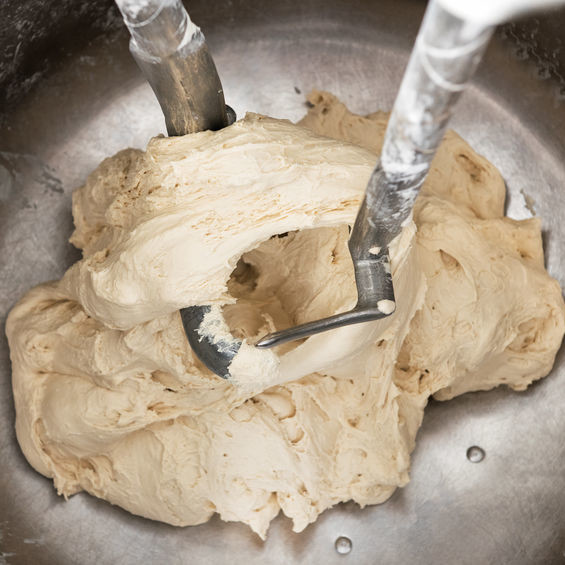
Water Absorption
Also Known as Water Hydration or Water Absorption Capacity (WAC)
What is Water Absorption?
Water absorption is the amount of water taken up by flour to achieve the desired consistency and create a quality end-product. It is the optimal amount of water you can add to a dough before it becomes too sticky to process.
- It is usually defined by flour weight.
- For example, 60% water absorption means 60 lbs of water is used to hydrate 100 lbs of flour.
How does water absorption work?
When flour and water are mixed together, water molecules hydrate the gluten-forming proteins gliadin and glutenin, as well as damaged starch and the other ingredients. The hydration process is achieved when protein and starch molecules create hydrogen bonds and hydrophilic interactions with the water molecules.
Particles hydrate by rubbing against each other and contacting water. Process parameters such as type of mixer, beating arm, water flow and pressure remove the hydrated surface layer and expose a new layer of the particle to the excess water so the water diffusion process can continue.
Function
Water absorption influences the following parameters of baking and bread:
- Loaf volume1
- Fracture stress of bread crumb1
- Bread yield2
- Machinability3
- Proofing3
- Final products attributes3
- Shelf life3
How to measure water absorption
A farinograph is usually used and can provide an approximate value for water absorption.
The test is based first on the determination of the optimal amount of water to achieve a consistent Brabender Unit value or BU. The amount of water required to produce this consistency is the water absorption of a flour. The analysis of the typical farinograph curve yields important quality parameters such as:
- Arrival time to first achieve 500 BU
- Optimum mix time, also called dough development time
- Departure time
- Mixing Tolerance Index (MIT)
- Dough stability4
Application
Similar to other rheological tests, water absorption is often used by millers and bakers to determine the incoming flour quality and its usage.
Influencing factors of flour water absorption:
- Moisture content: the lower the moisture content the higher the water absorption.
- Starch: The higher the starch damage the greater is flour water absorption.
- Proteins: the higher protein content the higher water absorption.
- Pentosans: the higher the pentosans content the higher the water absorption.
- Vital wheat gluten (VWG): When added to the formula, it will increase the water absorption and impart greater stability to the dough.5
- Enzymatic activity: sprouting or high amylase content decreases water absorption capacity.
Classification of flour according to its water absorption
Wheat flours can be classified as:6
| Flour type | Water absorption | Development Time | MTI |
| Very strong flour | >63% | >10 min | <10 FU |
| Strong flour | >58% | 4- 8 min | 15 – 50 FU |
| Medium strength flour | 54-60% | 2.5 – 4 min | 60 -100 FU |
| Weak flour | <55% | <2.5 min | >100 FU |
FU: Farinograph Unit, equivalent to Brabender Units.
Under- and over-absorption in bakery products
Different bakery products require different water absorption or hydration levels. Each level is unique for each kind of baked good to achieve the desired dough consistency and finished product characteristics.
The following are common problems that can occur during mixing. Both under- and over-absorption lead to quality issues in the dough and finished product:6
| Under-absorption | |
| Dough | Finished product |
|
|
| Over-absorption | |
| Dough | Finished product |
|
|
Official methods of analysis of water absorption:
- AACC Method 54-50.01. Determination of the Water Absorption Capacity of Flours and of Physical Properties of Wheat Flour Doughs, Using the Consistograph.
- AACC Method 54-21.02: Rheological Behavior of Flour by Farinograph: Constant Flour Weight Procedure
- ICC Standard Method 179: Determination of Water Absorption Capacity of Wheat Flours and Wheat Meals and Physical Properties of Wheat Dough Using the Haubelt Flourgraph E6.
- ICC Standard Method 171: Determination of the water absorption capacity of wheat flours and of physical properties of wheat flour dough using the Consistograph.
- ICC Standard Method 115/1: Method for using the Brabender Farinograph
References
- Zghal, M. C., M. G. Scanlon, and H. D. Sapirstein. “Effects of Flour Strength, Baking Absorption, and Processing Conditions on the Structure and Mechanical Properties of Bread Crumb.” Cereal Chemistry Journal 78.1 (2001): 1-7.
- Puhr, D. H., and B. L. D’Appolonia. “Effect of Baking Absorption on Bread Yield, Crumb Moisture, and Crumb Water Activity.” Cereal Chem. 69.5 (1992): 582-86.
- Pyler, E. J. “Physical and Chemical Test Methods.” Baking Science & Technology. Merriam, Kan.: Sosland Pub., 1988. 851-71.
- Serna-Saldivar, S.O. “Quality Control of Cereal Grains and Their Products.” Cereal Grains: Properties, Processing, and Nutritional Attributes, CRC Press, Taylor & Francis Group, 2010, pp. 491–493.
- Sumnu, S.G., and Sahin, S. “Functions of Ingredients in the Baking of Sweet Goods.” Food Engineering Aspects of Baking Sweet Goods, CRC Press, Taylor & Francis Group, 2008, pp. 37–39.
- Serna-Saldivar, S.O. “Dry-Milling Processes and Quality of Dry-Milled Products.” Cereal Grains: Laboratory Reference and Procedures Manual, CRC Press, Taylor & Francis Group, LLC, 2012, pp. 151–153.
- AIB International. Bread Manufacturing Process, Distance Learning Course, “Module 02 – Mixing.”https://www.aibonline.org/Start-Your-Training/Baking/Baking-Foundations/Bread-Manufacturing-Process-Online, 2018.

